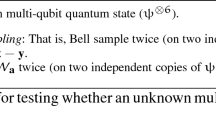Abstract
The linear separability concepts are applied in order to give either necessary or sufficient conditions for realizability by exactlyn threshold elements of a given coded cycle set of an autonomous nonsingular sequential circuit, specified byn boolean functions. Two main classes are obtained, the self-dual and the pure majority classes corresponding respectively to a necessary and to a sufficient condition. Also “necklace” circuits are described which exhibit remarkable properties. The number ofrealizable, non singular autonomons circuits are enumerated up ton=5, and one investigates also the capability of circuits ofn threshold elements to perform a state cycle of length2 n. Finally, in Appendix I, a constructive method to generate a non singular transition table is given.
Similar content being viewed by others
Bibliografia
Calaniello, E. R., “Outline of a theory of thought processes and thinking machines”, J. of Theor. Biol.2, 204–235 (1961).
Elgot, C. C., “Truth Functions Realizable by Single Threshold Organs” A.I.E.E. Conf. Paper no. 60-1311 (1960).
Winder, O. R., “Single Stage Threshold Logic”, A.I.E.E. Conf. Paper no. 60-1261 (1960) and Ph. D. dissertation Princeton (1962).
Ashby, W. R., Von Forster, H. andWalker, C. C.,Threshold and Stability in large networks., Techn. Rept. no. 3 Elec. Eng Res. Lab.-University of Illinois, (1962).
Smith, D. R. andDavidson, C. H., “Maintened activity in neural nets”, J. ACM9, 268 (1962).
Gambardella, G. andTrautteur, G., “Experimental Observations on a small active network”, Kybernetik3, 8–13 (1966).
Kautz, W. H., “State Logic Relations in Autonomous Sequential Networks” Proc. E.J.C.C. 119–127 (1958).
Krohn, K, andRhodes, J., “Nets of threshold elments”, Inf. Control8, 579–588 (1965).
Drago, A., “Anti-Dual logical functions” Calcolo3, 1–4 (1966).
Miller, R. E., “Switching Theory”, vol. 1, p. 304, J. Wiley Inc., N. Y. (1965).
Wang, K. C., “Transition graphs of affine transformations on vector spaces over finite fields”, preprint (1966).
Riordan, J., “An introduction to combinatorial analysis”, J. Wiley (1958) p. 162.
Elspas, B., “The Theory of autonomous linear sequential networks”, IRE Trans. on Circuit Theory. CT-6, pp. 45–60 (1959).
Elspas, B., “Self-complementary symmetry types of Boolean functions”, IRE Trans. on Electronic computers, pp. 264–266 (1960).
Slepian, D. “On the number of symmetry types of Boolean functions of n variables”, Can. J. Math.5, 185–193 (1953).
Drago, A., “Rules to find the partition of n with maximum l.c.m.”, (in corso di stampa).
Author information
Authors and Affiliations
Additional information
Questa ricerca è stata finanziata in parte dall' U.S.A.F. sotto il Grant n. 65-44 tramite l'European Office, Office of Aerospace Research-Brnxelles.
Rights and permissions
About this article
Cite this article
Crocchiolo, C., Drago, A. Circuiti autonomi nonsingolari din elementi binari, realizzabili medianten elementi a soglia. Calcolo 4, 91–105 (1967). https://doi.org/10.1007/BF02641646
Received:
Issue Date:
DOI: https://doi.org/10.1007/BF02641646




